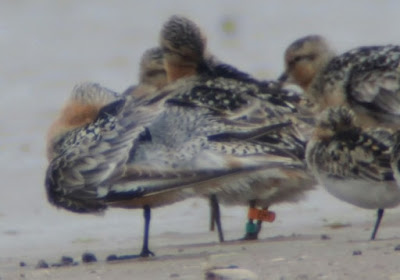Recent reports that NE Greenland was blanketed in snow in the breeding season suggested that 2018 might be a wipe out for Arctic-breeding waders, and this coming after very poor breeding productivity for Red Knot (Calidris canutus islandica) in 2017. The juveniles aren’t due to arrive in the UK just yet, but there may be a glimmer of hope from analyzing the biometrics of colour-ringed adults resighted just after they returned from the north.
On 22nd September 2017 and 30th March 2018 a team including many members of South West Lancs, North Lancs and SCAN Ringing Groups fitted about 1,000 Red Knot with coded orange flags at Altcar Training Camp near Formby, Merseyside and recorded their wing and bill lengths. Since the middle of July we have been observing their return to the beaches around the ringing site. Arrival started on 15th July and numbers grew over the next weeks. By reading the flag codes we could identify which individuals had returned.
Looking at the biometrics of the Red Knot that we read between 22nd and 31st July we were intrigued to see that on average they had statistically longer wing and bill than the whole catch population (see graph). Furthermore, flagged Red Knot that were newly observed on 3rd and 6th August had an average smaller wing and bill than these early arrivals. Since female Red Knot are on average larger than males this is an indication of the females arriving back before the males. As female Knot leave the breeding grounds shortly after the eggs hatch whereas the males remain until the chicks fledge this, in turn, is an indication of probable breeding success.
Time will tell, but maybe our readings of flagged Red Knot offer hope that although NE Greenland had nil productivity, there has been success elsewhere in islandica Red Knot’s breeding range, which extends across Arctic Canada.
Our analysis of Red Knot arrivals would not have been possible without colour ringing and all colour ring sightings are valuable. Many of these Red Knot were observed in Iceland on their Northwards migration. As such, interesting life histories are building up in a short space of time. If you see a colour ringed bird please report it via www.ring.ac or contact the ringer directly. For waders, the Register of colour-ringing schemes maintained by the International Wader Study Group (IWSG) is a good way to track down the ringer, at the Wader Study Group register.
Rose A. Maciewicz & Peter J. Knight 10th August 2018


No comments:
Post a Comment